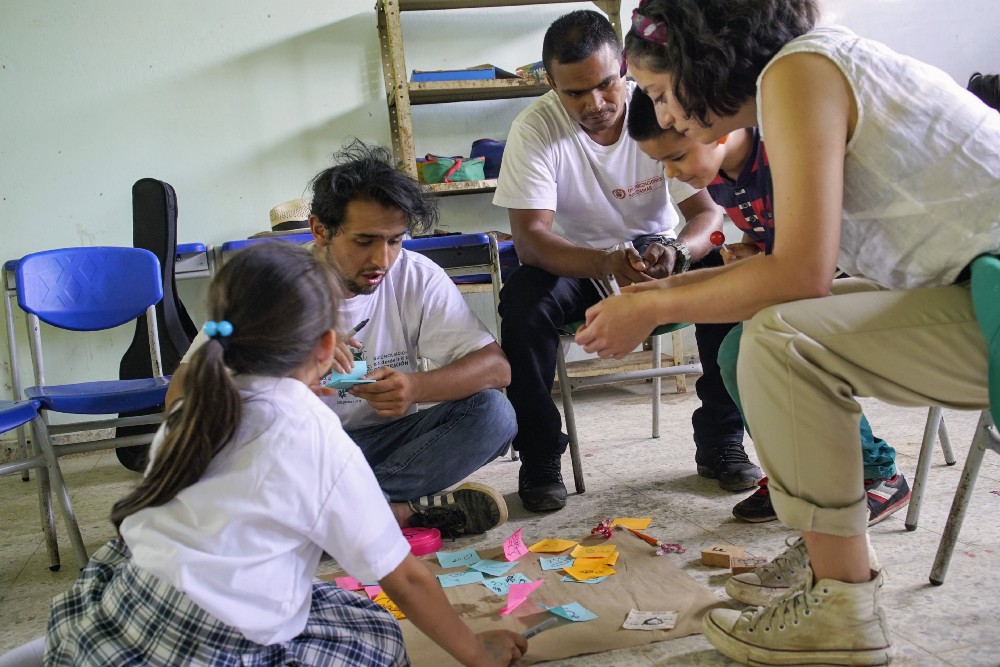
01 - Trying to do research with kids.

01 - Trying to do research with kids.
It’s dark when we finally arrive in a tiny village in the Colombian Amazon. It’s been raining all day and the unpaved roads have been difficult. As we drive in, we peek out of the bus to see rows of identical houses, and the dark outline of palm trees.
We can’t see much else but we know we’ve arrived at the territory we’ll be staying at for the next 16 days — Las Colinas, a reincorporation territory for ex-guerrilla members of the FARC.
Las Colinas, a reincorporation territory in Guaviares, Colombia. I’m in Las Colinas, as a participant of IDDS (International Design Development Summit). The plan for the next 16 days is to learn about design, and using woodworking tools, and then to use those learnings to tackle a problem and build a prototype.
For the first few days, I was particularly curious about what I considered the end goal: the prototype. Perhaps it was tech culture creeping in — the idea that there’s nothing to celebrate unless the feature has been released, and the KPI has gone up.
But, perhaps is was just me, and the fact that I’d lost sight of what design is all about: people.
My team doing initial research with our little users. Photo by Ricardo Salgado Cadena. People as part of the design process. In IDD-Summits, we use “co-creation” as a process for designing and building the prototype.
Co-creation means that professional designers are designing together with the end users, as well as other professionals who are not designers. In my smaller group we had a local woman who kept a farm, a software engineer, two ex-guerrilla men, a physics teacher, a psychologist, and a teenage girl who was the daughter of an ex-guerrilla.
It was these team members who taught me a few lessons of what designing with people in mind meant.
Farly, approaching a family’s home. Photo by Ricardo Salgado Cadena. 1 — Listen like a friend. When it came to doing field studies, I was preparing by writing a set of interview questions and themes. While they came in handy to refresh our memory, the more challenging part was helping people feel comfortable enough around you to learn from them.
One co-designer, Farly — a physics teacher, would approach people with such warmth and genuine curiosity, that people quickly invited us in to their homes and pulled out chairs for us. She did this by positioning herself as a new friend, as opposed to a professional.
Another co-designer, Carlos — a developer, would invite locals to our workshop whenever they had time. While this seemed slightly chaotic to me at first, people felt welcome to approach us for feedback at all points of our design process.
What both Farly and Carlos had in common was quite simply that they treated everyone in the community as co-creators and friends, they were open to not only to feedback but also conversations.
2 — Create inviting environments. The problem we were solving revolved around small children and parents, so during our field research we visited schools and homes.
Given that I didn’t have experience designing for children, I wasn’t quite sure how to approach them. I had a set of questions, and tried to incorporate them as a children’s game. While this worked fine— it wouldn’t have worked as well if it weren’t for Pablo, another designer, and his guitar.
Pablo’s songs and musical games relaxed the children and made for a more joyous environment, both in the field studies and in the workshop. This helped the community know we weren’t only there to ask questions, but to get to know them and have fun.
Lucila and Luna, the designers for our children’s board game. 3 — Include end users in the design process. Throughout the design process, two of the people who I worked most closely with were Lucila, a local mother, and Luna, a local teenager. Their involvement in the project was vital both for the process and outcome of the project.
Given that they were local to the region, their ideas were often much more contextually relevant than some of the non-locals. For example, when we were designing a children’s toy, they knew what the popular local animals were and their local slang names.
Additionally, since the prototype we were building was meant to be used locally in that region, it was vital that there was direct buy-in and support from locals. As designers of the object, they could advocate for the solution in a way that was much more convincing than if it was coming from outsiders.
Design isn’t always about the end product. It’s about people. Their problems, their goals, their dreams — and ways to empower them.
If I could go back to that first day in Las Colinas, I’d forgot all about the “end goal” and focus on the people again. That’s the root of it.
⟵ More posts